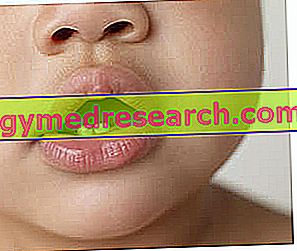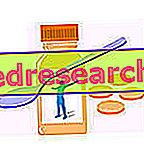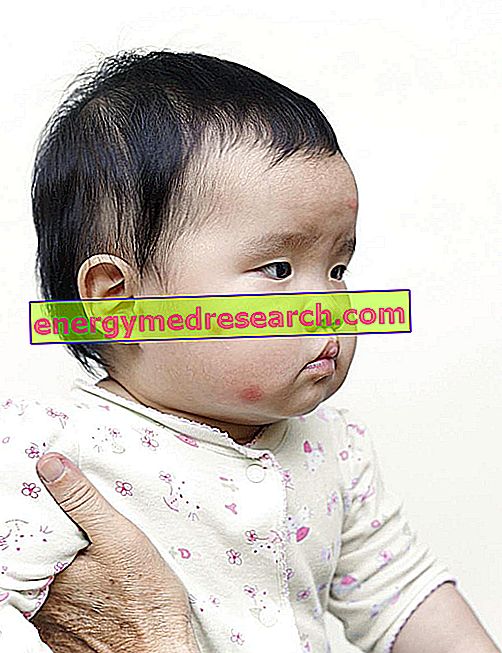Already during pregnancy ...
The best way to take care of milk teeth is prevention.

Curiosity
When taken by the pregnant woman for long periods, some drugs - such as tetracyclines - can alter the natural dental pigmentation (yellow teeth) and weaken the enamel in the baby's future milk teeth. In the long term, these drugs can therefore indirectly favor the formation of caries in milk teeth.
During the neonatal age ...
When the first milk teeth appear, the child is still too young to brush his teeth alone: it is therefore necessary for the parents to start taking care of their child's teeth. Clearly, in this delicate growth phase, milk teeth cannot be washed with a toothbrush and toothpaste. The cleaning of milk teeth cannot therefore be performed in the same way as the adult's teeth are washed: the child would in fact run the risk of swallowing the toothpaste or traumatizing the gums with the toothbrush, going towards a series of even serious problems (eg fluorosis, in case of ingestion of large quantities of fluoride toothpaste).

During neonatal age, the baby should be breastfed to prevent tooth decay in milk teeth. Breast milk, in fact, strengthens the teeth favoring mineralization with calcium and phosphorus and - unlike the vaccine (cow) - helps protect the enamel of milk teeth.
During childhood ...
A correct diet, abundant in vegetables, balanced in terms of proteins (meat and fish), and poor in refined sugars, sweets and junk food can do nothing but positively affect the health of milk teeth: a diet so not only set it prevents the typical disorders of the modern age (first of all overweight, childhood obesity and related metabolic diseases), but it also encourages the correct development of teeth.
The children are attracted by sweets, snacks, hyper-sugared snacks, gummy sweets, caramelized fruit and so on. Although objectively gluttonous, these "foods" constitute a real threat to the teeth: the excessive consumption of sugars goes to alter the natural bacterial balance of the oral cavity, thus predisposing the child to dental infections, first of all caries. It is therefore important to make the child understand which foods are "good" to prefer and "bad" to avoid or at least to eat sporadically (then immediately running to brush your teeth).
Do not think, however, that tooth decay can be prevented simply by following a correct diet: the teeth require toothpaste and a toothbrush to remove food and plaque residues that, inevitably, anchor to the teeth after each meal.
As soon as the child is able to use the toothbrush alone, it is a good idea to educate him in the correct use of dental cleaning tools. Clearly, at this age, it is not necessary (indeed, it is contraindicated) to use dental floss or brush, as it could injure or damage the gums.
The choice of the toothbrush is important: it must have a small head just enough to be able to brush the milk teeth, and the bristles that compose it should be soft. The movements of the toothbrush must be delicate and precise, that is directed from the gum always towards the tooth : a contrary movement (from the tooth towards the gum) can, in the long term, favor the appearance of the gums withdrawn.
Not to forget the chewing surface of the teeth: even in this area, in fact, caries and other dental infections can occur giving rise to terrible toothaches. According to this, it is well understood how important it is to brush this area too, insisting in the intercuspid space originated by the 4 tips of the molars: being similar to a depression, this space constitutes an ideal area for the deposition of the plaque, consequently it can favor caries.
Another essential point to take care of milk teeth is the choice of toothpaste. Fluorinated toothpastes for children can only be used if the concentration of fluoride does not exceed 500-600 ppm (toothpastes for adults contain a variable amount of fluoride from 1100 to 1500 ppm). As anticipated, the risk that a child runs using fluoride toothpaste is to swallow it, thus absorbing excessive doses of fluoride.
To prevent tooth decay, however, some doctors suggest supplementing the child's diet with fluoride supplementation : the dose of the supplement should always be established by the doctor, the only one able to establish the dosage indicated for the child.
Watch the video
X Watch the video on youtubeCarious milk teeth
When the milk teeth are cariano, the only intelligent and thinkable solution is the filling. It is good, therefore, to abandon the idea of not treating decayed milk teeth because they are destined to fall. Leaving them rot (literally), the decayed milk teeth are destined to a pathological fall, therefore against nature. In doing so, the permanent teeth that will take their place - still included in the gum and not completely ready to erupt in the oral cavity - tend to grow badly. In such circumstances, the child runs the risk of having crooked teeth or, worse still, suffering from dental malocclusion: these problems should not be underestimated, since they can only be corrected with the use of the appliance.
Did you know that ...
In the most serious cases, a problematic dental malocclusion (permanent dentition) may require the extraction of the crooked tooth and the subsequent repositioning of the same in the correct position.
Clearly, we have reported an extreme case, an extreme example, but it is good to know all the eventualities that could be faced by letting the milk teeth fall off themselves because they are seriously ill.
After the fall of the milk teeth
A valuable suggestion to keep in mind after the fall of the milk teeth and the subsequent eruption of the permanent teeth is the dental sealing. This very important treatment, often unfortunately underestimated, guarantees good coverage from the onset of caries in the teeth where it is performed. For this purpose, it is advisable to seal the masticatory surface of the molar teeth, more exposed to the risk of dental caries because they have deep furrows (inside which bacteria and plaque tend to anchor).
After the fall of the milk teeth, the new permanent teeth require a certain "maintenance": for this reason, regular checks by the dentist, at least once or twice a year, are indispensable to surprise in the bud eventual ailments or still silent dental infections .



